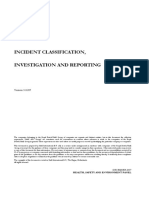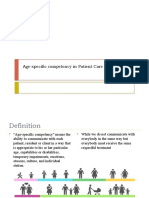Algae
Algae
Uploaded by
Twu FamCopyright:
Available Formats
Algae
Algae
Uploaded by
Twu FamCopyright
Available Formats
Share this document
Did you find this document useful?
Is this content inappropriate?
Copyright:
Available Formats
Algae
Algae
Uploaded by
Twu FamCopyright:
Available Formats
ALGAE
What is Algae?
When high levels of nutrients drain into water reservoirs algae will usually form in large quantities generating blooms. For water use purposes the greatest concern arises from the growth of blue-green algae in the water. Blue-green algae are in fact not algae at all, but are bacteria and their proper name is cyanobacteria. Cyanobacteria produce both liver and brain toxins that can be as potent as cobra snake venom. The cyanobacteria Microcystis, Anabaena, and Aphanizomenon are common on water reservoirs and lakes across the prairie region. 3This picture shows a highly toxic strain of the cyanobacterium Microcystis. An agricultural stream in the foreground carrying clear, but nutrient-laden, water into a lake. This resulted in the proliferation of the cyanobacterium Microcystis.
3Close-up of the Microcystis bloom. As a rule, dugout water will be loaded with particles, including algae, while the water from the South Saskatchewan River will rarely have a high level of particles in it. Particles of concern are very small and are usually seen as a haze; a microscope is needed to see them clearly. In addition most dugout waters are typically brown in colour (caused by organic compounds) while water from the South Saskatchewan River is clear. Even after treatment, water from dugouts usually retain their colour as shown in the picture below. 3Water distributed in a small community close to Saskatoon and in City of Saskatoon. Why does it matter if the water is brown and loaded with organic material? Dugouts typically contain up to 10 times more dissolved organics than the South Saskatchewan River, from which cities like Calgary and Saskatoon get their water. Untreated South Saskatchewan River water has almost no colour. The dissolved organics present in rural water supplies often smell and taste bad and they make it more difficult to disinfect the water. When one adds chlorine it reacts with the organics rather than killing the microbes. When the chlorine reacts with the dissolved organics, compounds that can cause cancer are formed. If properly disinfected, rural Saskatchewan water supplies will generally exceed guidelines for such compounds. In addition to organics, rural water supplies often contain agricultural chemicals such as pesticides. Water entering farm houses (and small rural communities) may not only look unappealing, but can also have unpleasant smells associated with it. It is unlikely that water that looks and smells poor is safe, even if toxic compounds and microorganisms dont smell or taste.
www.safewater.org
Page 1 of 4 4
3This is a picture of a farmer running water from the kitchen tap. The origin of this farmers problem was excessive growth of algae in the dugout supplying the water. This water made the whole house smell like rotten eggs.
www.safewater.org
You might also like
- Fundamentals Workbook ENG RevDocument25 pagesFundamentals Workbook ENG RevottozirgNo ratings yet
- Water Kangen USA MagazineDocument34 pagesWater Kangen USA MagazineWaterKangenUSA100% (22)
- MarronDocument11 pagesMarronp25digital2100% (1)
- The Day You Went AwayDocument4 pagesThe Day You Went AwayTwu FamNo ratings yet
- Interpreting Water Tests For Ponds and LakesDocument3 pagesInterpreting Water Tests For Ponds and LakesMuhammad EhtshamNo ratings yet
- Drinking Water From Household Wells: Cover Photo Courtesy of Charlene E. Shaw, U.S. Environmental Protection AgencyDocument24 pagesDrinking Water From Household Wells: Cover Photo Courtesy of Charlene E. Shaw, U.S. Environmental Protection AgencymiragefallingskyNo ratings yet
- JAi Mata DiDocument2 pagesJAi Mata DiDharmendra GuptaNo ratings yet
- Alage Causing Biological Disturbances One of The Best Topic of AlgaeDocument18 pagesAlage Causing Biological Disturbances One of The Best Topic of AlgaeNihar ParmarNo ratings yet
- Water Quality TestingDocument20 pagesWater Quality Testingapi-26228968No ratings yet
- Types of Impurities in WaterDocument1 pageTypes of Impurities in WaterBalvinder Singh100% (1)
- Cyanobacteria FaqDocument2 pagesCyanobacteria FaqMilesNo ratings yet
- WATER WEED REMOVER NewDocument50 pagesWATER WEED REMOVER NewmujeebNo ratings yet
- Drinking Water RisksDocument2 pagesDrinking Water Risksapi-251369588No ratings yet
- Detailed Note On Algal BloomDocument1 pageDetailed Note On Algal Bloombashantsahani060No ratings yet
- New Information Note Dissolved OxygenDocument3 pagesNew Information Note Dissolved OxygenDeva AnandNo ratings yet
- ReviewerDocument5 pagesReviewer10A NAWAF A. GUMAGANo ratings yet
- Au SC 2132 River Pollution and Water Filter Activity Powerpoint English - Ver - 2Document11 pagesAu SC 2132 River Pollution and Water Filter Activity Powerpoint English - Ver - 2Phượng NguyễnNo ratings yet
- River Pollution: Polluting The RiversDocument3 pagesRiver Pollution: Polluting The RiversAaronAlwynNo ratings yet
- Pond AlgaeDocument25 pagesPond Algaeajik indiantoNo ratings yet
- Algae - What 2 PageDocument2 pagesAlgae - What 2 PageVignesh LalNo ratings yet
- 4-1 Introduction: This Chapter Was Written by John A. Eastman, PH.D., of Lockwood, Jones and Beals, Inc., Kettering, OHDocument12 pages4-1 Introduction: This Chapter Was Written by John A. Eastman, PH.D., of Lockwood, Jones and Beals, Inc., Kettering, OHSirajuddin AhmedNo ratings yet
- Water Pollution An OverviewDocument10 pagesWater Pollution An OverviewShashi Kiran PandeyNo ratings yet
- What Causes Water PollutionDocument5 pagesWhat Causes Water Pollutionwednesday08No ratings yet
- Identifying and Managing Aquatic Vegetation: PurdueDocument19 pagesIdentifying and Managing Aquatic Vegetation: PurdueMuraleetharan BoopathiNo ratings yet
- Water PollutionDocument3 pagesWater PollutionsahilmaknojiyaNo ratings yet
- Water PurityDocument2 pagesWater PuritySwamy ManiNo ratings yet
- Did Your Can of Soda Kill A Whale? Water Pollution for Kids | Children's Environment BooksFrom EverandDid Your Can of Soda Kill A Whale? Water Pollution for Kids | Children's Environment BooksNo ratings yet
- Algal BloomDocument4 pagesAlgal BloomDEVI TEJASWININo ratings yet
- Water Pollution Lecture Notes Five CIE 442 (Edited)Document67 pagesWater Pollution Lecture Notes Five CIE 442 (Edited)Anthony MulengaNo ratings yet
- 000Document1 page000Annjella OrielNo ratings yet
- A Guide To Water FiltrationDocument4 pagesA Guide To Water FiltrationMihai PopaNo ratings yet
- Water Treatment_IntorductionDocument20 pagesWater Treatment_Intorductionengineerala2022No ratings yet
- Reverse Osmosis Water Filter Guide Truth Lies Minerals Your HealthDocument8 pagesReverse Osmosis Water Filter Guide Truth Lies Minerals Your Healthgeneccw100% (1)
- ScriptDocument3 pagesScriptapi-549407673No ratings yet
- Water PollutionDocument27 pagesWater PollutionKarylleNo ratings yet
- Freshwater Algal BloomsDocument3 pagesFreshwater Algal BloomsVitoo OinamNo ratings yet
- Water Report - QualityDocument8 pagesWater Report - QualityEric ReynoldsNo ratings yet
- 04 Module 2 Lesson 2 Chemical Properties of WaterDocument9 pages04 Module 2 Lesson 2 Chemical Properties of WaterBruce GreenNo ratings yet
- Water PollutionDocument4 pagesWater PollutionMariano DomingoNo ratings yet
- Azolla Fact SheetDocument2 pagesAzolla Fact SheetSaurav GutgutiaNo ratings yet
- Algae: Main Habitat PreferencesDocument11 pagesAlgae: Main Habitat PreferencesHummayun RasheedNo ratings yet
- Water PollutionDocument9 pagesWater PollutionaarushrshirpewarNo ratings yet
- Whats Wrong With Our Faucet Water? Whats Wrong With Our Faucet Water?Document2 pagesWhats Wrong With Our Faucet Water? Whats Wrong With Our Faucet Water?Geoffrey LymanNo ratings yet
- Experiment Time... : Presentation NotesDocument5 pagesExperiment Time... : Presentation Notessadia122No ratings yet
- Lesson 2 - Water and Waste Water ManagementDocument11 pagesLesson 2 - Water and Waste Water ManagementPaul Assie RosarioNo ratings yet
- FAQ Blue-Green Algae (Cyanobacteria)Document5 pagesFAQ Blue-Green Algae (Cyanobacteria)Metro News CanadaNo ratings yet
- LSC Pre TestDocument13 pagesLSC Pre TestArka DeyNo ratings yet
- B6D4E1 Gather Information On Water PollutionDocument6 pagesB6D4E1 Gather Information On Water Pollutionnureen00No ratings yet
- Management of The Water Quality For Beef CattleDocument13 pagesManagement of The Water Quality For Beef CattleCamila CarmonaNo ratings yet
- Last YearDocument11 pagesLast YearBattlecruiser ScharnhorstNo ratings yet
- Water Pollution FinalDocument13 pagesWater Pollution Finalapi-226213609No ratings yet
- Research and Infographics Empowerment TechnologyDocument12 pagesResearch and Infographics Empowerment Technology10A NAWAF A. GUMAGANo ratings yet
- Types of Impurities in WaterDocument7 pagesTypes of Impurities in WaterAhmed BatunNo ratings yet
- Drinking Water and Health: What You Need To Know!Document11 pagesDrinking Water and Health: What You Need To Know!Hafiz Hibba Tur RahmanNo ratings yet
- How To Keep Pond Water Clean HealthyDocument20 pagesHow To Keep Pond Water Clean Healthyajik indiantoNo ratings yet
- Common Problems in Aquaculture and Their Preventive MeasuresDocument11 pagesCommon Problems in Aquaculture and Their Preventive MeasuresMuhammad AmjadNo ratings yet
- Fact Sheet: Marron Farming in South AustraliaDocument11 pagesFact Sheet: Marron Farming in South Australiap25digital2No ratings yet
- Narayanan Srikanth - Mercury in The Wabigoon-English River System - AssignmentDocument4 pagesNarayanan Srikanth - Mercury in The Wabigoon-English River System - Assignmentnarayanansri2007No ratings yet
- Chapter 1 Introduc Water Quality ManagementDocument26 pagesChapter 1 Introduc Water Quality ManagementDire AbdulaxifNo ratings yet
- Dwcat18 PDFDocument114 pagesDwcat18 PDFTwu FamNo ratings yet
- Pressure Sensors Sel 160502Document4 pagesPressure Sensors Sel 160502Twu FamNo ratings yet
- Nanosilver - Making Difficult Decisions: Nanosrebro - Podejmowanie Trudnych DecyzjiDocument12 pagesNanosilver - Making Difficult Decisions: Nanosrebro - Podejmowanie Trudnych DecyzjiTwu FamNo ratings yet
- Good Health and Well-BeingDocument7 pagesGood Health and Well-Beingsgjalmi23No ratings yet
- What Is A Health Care Profession?: Chapter Iv: The Calling of The Health Care ProviderDocument14 pagesWhat Is A Health Care Profession?: Chapter Iv: The Calling of The Health Care ProviderNur SanaaniNo ratings yet
- BeggingDocument4 pagesBeggingAliRazaNo ratings yet
- Chapter 18 - Self-Assessment Q&ADocument6 pagesChapter 18 - Self-Assessment Q&AGustavo BobadillaNo ratings yet
- Should Animaltesting Be Banned 1Document5 pagesShould Animaltesting Be Banned 1Abeerah TariqNo ratings yet
- DC-5 - Lesson 1Document12 pagesDC-5 - Lesson 1Amit Kr GodaraNo ratings yet
- Voluntary Health AgenciesDocument105 pagesVoluntary Health Agenciesritikaritika0% (2)
- Cameroon: National ReportDocument25 pagesCameroon: National ReportguyNo ratings yet
- Keraguard: Powerful Protection and Repair For HairDocument12 pagesKeraguard: Powerful Protection and Repair For HairSANo ratings yet
- ICU Journal AdditionDocument4 pagesICU Journal AdditionPaula TapilNo ratings yet
- 37981-iUBT311 Treatment Evidence Form v2Document5 pages37981-iUBT311 Treatment Evidence Form v2Aline Brito Ferreira de CastroNo ratings yet
- Incident Classification, Investigation, and Reporting ManualDocument58 pagesIncident Classification, Investigation, and Reporting Manualpariman modNo ratings yet
- MANN-FILTER Catálogo Europa (Online) - Comentario Del Producto Combustible PL 271 - 1Document3 pagesMANN-FILTER Catálogo Europa (Online) - Comentario Del Producto Combustible PL 271 - 1Juan Carlos Benitez MartinezNo ratings yet
- Endodontic Microbiology: Review of Literature: January 2011Document14 pagesEndodontic Microbiology: Review of Literature: January 2011Muhammad RaihanNo ratings yet
- Childcare Resume 1Document2 pagesChildcare Resume 1api-704123206No ratings yet
- Meningitis HXDocument2 pagesMeningitis HXAnishilNo ratings yet
- HRDV 5630-Chapter 9 - EmpowermentDocument30 pagesHRDV 5630-Chapter 9 - EmpowermentGirlie BernardinoNo ratings yet
- Midterm Quiz BankDocument18 pagesMidterm Quiz Bankbennyboy920140% (5)
- Guidelines For Quality Control Testing For Digital CR DR Mammography V4Document62 pagesGuidelines For Quality Control Testing For Digital CR DR Mammography V4khaerul0% (1)
- Charqui Golden VacDocument25 pagesCharqui Golden VacMartin100% (1)
- Aditya BirlaDocument54 pagesAditya BirlaAbhi_IMK100% (1)
- Social and Political StratificationDocument59 pagesSocial and Political StratificationJoshkorro Geronimo100% (1)
- Algoritm Trat Algoritm Tratament Astm Bronsic - Pdfament Astm BronsicDocument1 pageAlgoritm Trat Algoritm Tratament Astm Bronsic - Pdfament Astm BronsicSbarcea AurelNo ratings yet
- Fragile X Syndrome EssayDocument4 pagesFragile X Syndrome Essayapi-338677507No ratings yet
- Progress Test 04Document6 pagesProgress Test 04Lemmy the GamerNo ratings yet
- Indian Standard Basic Requirements For Hospital Planning: 0. ForewordDocument2 pagesIndian Standard Basic Requirements For Hospital Planning: 0. ForewordAr Aditya SagarNo ratings yet
- Carti Psihologie TitluriDocument2 pagesCarti Psihologie TitluriMelancholya Shin Ji MingNo ratings yet
- Training - Age Specific CompetencyDocument14 pagesTraining - Age Specific CompetencyKrishna Hospital & Research Centre HaldwaniNo ratings yet
- Drug Delivery On Rectal Absorption: Suppositories: Review ArticleDocument7 pagesDrug Delivery On Rectal Absorption: Suppositories: Review ArticleNindah IkaNo ratings yet





























































































